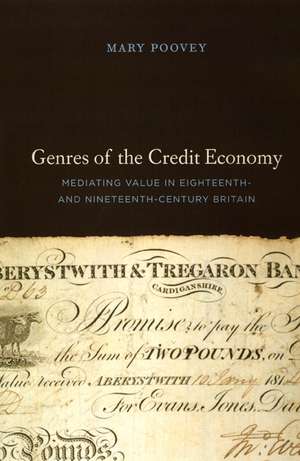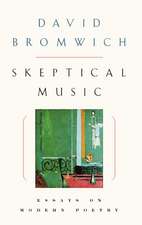Genres of the Credit Economy: Mediating Value in Eighteenth- and Nineteenth-Century Britain
Autor Mary Pooveyen Limba Engleză Paperback – 10 apr 2008
How did banking, borrowing, investing, and even losing money—in other words, participating in the modern financial system—come to seem likeroutine activities of everydaylife? Genres of the Credit Economy addressesthis question by examining the history of financial instruments and representations of finance in eighteenth- and nineteenth-century Britain.
Chronicling the process by which some of our most important conceptual categories were naturalized, Mary Poovey explores complex relationships among forms of writing that are not usually viewed together, from bills of exchange and bank checks, to realist novels and Romantic poems, to economic theory and financial journalism. Taking up all early forms of financial and monetarywriting, Poovey argues that these genres mediated for early modern Britons the operations of a market system organized around credit and debt. By arguing that genre is a critical tool for historical and theoretical analysis and an agent in the events that formed the modern world, Poovey offers a new way to appreciate the character of the credit economy and demonstrates the contribution historians and literary scholars can make to understanding its operations.
Much more than an exploration of writing on and around money, Genres of the Credit Economy offers startling insights about the evolution of disciplines and the separation of factual and fictional genres.
Chronicling the process by which some of our most important conceptual categories were naturalized, Mary Poovey explores complex relationships among forms of writing that are not usually viewed together, from bills of exchange and bank checks, to realist novels and Romantic poems, to economic theory and financial journalism. Taking up all early forms of financial and monetarywriting, Poovey argues that these genres mediated for early modern Britons the operations of a market system organized around credit and debt. By arguing that genre is a critical tool for historical and theoretical analysis and an agent in the events that formed the modern world, Poovey offers a new way to appreciate the character of the credit economy and demonstrates the contribution historians and literary scholars can make to understanding its operations.
Much more than an exploration of writing on and around money, Genres of the Credit Economy offers startling insights about the evolution of disciplines and the separation of factual and fictional genres.
Preț: 288.61 lei
Nou
Puncte Express: 433
Preț estimativ în valută:
55.23€ • 60.18$ • 46.54£
55.23€ • 60.18$ • 46.54£
Carte tipărită la comandă
Livrare economică 23 aprilie-07 mai
Preluare comenzi: 021 569.72.76
Specificații
ISBN-13: 9780226675336
ISBN-10: 0226675335
Pagini: 496
Ilustrații: 6 halftones
Dimensiuni: 152 x 229 x 33 mm
Greutate: 0.69 kg
Ediția:First Edition
Editura: University of Chicago Press
Colecția University of Chicago Press
ISBN-10: 0226675335
Pagini: 496
Ilustrații: 6 halftones
Dimensiuni: 152 x 229 x 33 mm
Greutate: 0.69 kg
Ediția:First Edition
Editura: University of Chicago Press
Colecția University of Chicago Press
Notă biografică
Mary Poovey is the Samuel Rudin Professor in the Humanities andprofessor of English at New York University and author of, most recently, A History of the Modern Fact: Problems of Knowledge in the Sciences of Wealth and Society.
Cuprins
Acknowledgments
INTRODUCTION
PREAMBLE / Mediating Genres
Imaginative Genres
Financial Writing
Monetary Genres
ONE / Mediating Value
Writing about Money in the New Credit Economy
The Fact/Fiction Continuum
TWO / Generic Differentiation and the Naturalization of Money
Inciting Belief through Print
Sir James Steuart’s Principles of Political Economy: Between Fiction and Theory
Money Talks: Thomas Bridges’s Adventures of a Bank-Note
INTERCHAPTER ONE / “The Paper Age”
The Takeoff in the Book Trade
The Proliferation of Bank Paper
Differential Forms
THREE / Politicizing Paper Money
The First Currency Radical: William Cobbett Pits Paper against Gold
Labor Notes and a Coinage of Pottery: Robert Owen and John Bray
FOUR / Professional Political Economy and Its Popularizers
Raising the Profile of Economic Theory: Ricardo, McCulloch, Chalmers, and John Stuart Mill
Financial Journalism: Economic Writing for Middle-Class Readers
W. Stanley Jevons and the Narrowing of Economic Science
FIVE / Delimiting Literature, Defining Literary Value
Literary Value and a Hierarchy of Imaginative Genres
Hierarchies of Reading
Facts, Fictions, and Literary Value
INTERCHAPTER TWO / Textual Interpretation and Historical Description
Reading Martineau’s Illustrations of Political Economy: Exemplary Interpretations
Historical Description
SIX / Literary Appropriations
Jane Austen’s Gestural Aesthetic
From Gesture to Formalism: Little Dorrit and Silas Marner
The Rewards of Form: The Last Chronicle of Barset
CODA
Notes
Bibliography
Index
INTRODUCTION
PREAMBLE / Mediating Genres
Imaginative Genres
Financial Writing
Monetary Genres
ONE / Mediating Value
Writing about Money in the New Credit Economy
The Fact/Fiction Continuum
TWO / Generic Differentiation and the Naturalization of Money
Inciting Belief through Print
Sir James Steuart’s Principles of Political Economy: Between Fiction and Theory
Money Talks: Thomas Bridges’s Adventures of a Bank-Note
INTERCHAPTER ONE / “The Paper Age”
The Takeoff in the Book Trade
The Proliferation of Bank Paper
Differential Forms
THREE / Politicizing Paper Money
The First Currency Radical: William Cobbett Pits Paper against Gold
Labor Notes and a Coinage of Pottery: Robert Owen and John Bray
FOUR / Professional Political Economy and Its Popularizers
Raising the Profile of Economic Theory: Ricardo, McCulloch, Chalmers, and John Stuart Mill
Financial Journalism: Economic Writing for Middle-Class Readers
W. Stanley Jevons and the Narrowing of Economic Science
FIVE / Delimiting Literature, Defining Literary Value
Literary Value and a Hierarchy of Imaginative Genres
Hierarchies of Reading
Facts, Fictions, and Literary Value
INTERCHAPTER TWO / Textual Interpretation and Historical Description
Reading Martineau’s Illustrations of Political Economy: Exemplary Interpretations
Historical Description
SIX / Literary Appropriations
Jane Austen’s Gestural Aesthetic
From Gesture to Formalism: Little Dorrit and Silas Marner
The Rewards of Form: The Last Chronicle of Barset
CODA
Notes
Bibliography
Index












